Abstract
Previous studies in experimental animals indicate an important inhibitory interaction between cardiopulmonary and arterial baroreflexes. In the dog, for example, cardiopulmonary vagal afferents modulate carotid baroreflex control of vascular resistance. On the other hand, previous studies in human subjects have not produced convincing evidence of a specific interaction between these baroreceptor reflexes. The purpose of this study was to determine whether unloading of cardiopulmonary baroreceptors in humans with nonhypotensive lower body negative pressure selectively augments the reflex vasoconstrictor responses to simulated carotid hypotension produced by neck pressure. In nine healthy subjects, we measured forearm vascular responses with plethysmography during lower body negative pressure alone (cardiopulmonary baroreflex), during neck pressure alone (carotid baroreflex), and during concomitant lower body negative pressure and neck pressure (baroreflex interaction). Lower body negative pressure produced a greater than twofold augmentation of the forearm vasoconstrictor response to neck pressure. This increase in resistance was significantly greater (P less than 0.05) than the algebraic sum of the increase in resistance from lower body negative pressure alone plus that from neck pressure alone. In contrast, lower body negative pressure did not potentiate the forearm vasoconstrictor responses either to intra-arterial norepinephrine or to the cold pressor test. Thus, the potentiation of the vasoconstrictor response to neck pressure by lower body negative pressure cannot be explained by augmented reactivity to the neurotransmitter or to a nonspecific augmentation of responses to all reflex vasoconstrictor stimuli. In conclusion, nonhypotensive lower body negative pressure selectively augments carotid baroreflex control of forearm vascular resistance. These experiments demonstrate a specific inhibitory cardiopulmonary-carotid baroreflex interaction in humans.
Full text
PDF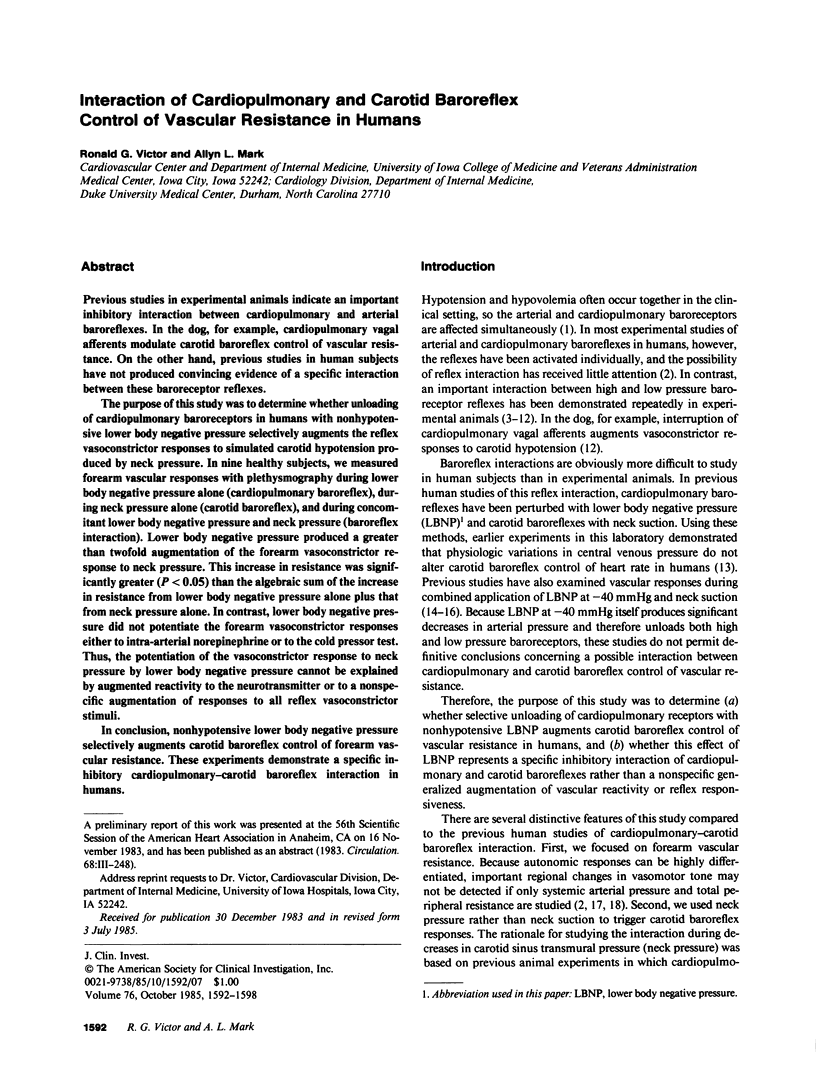
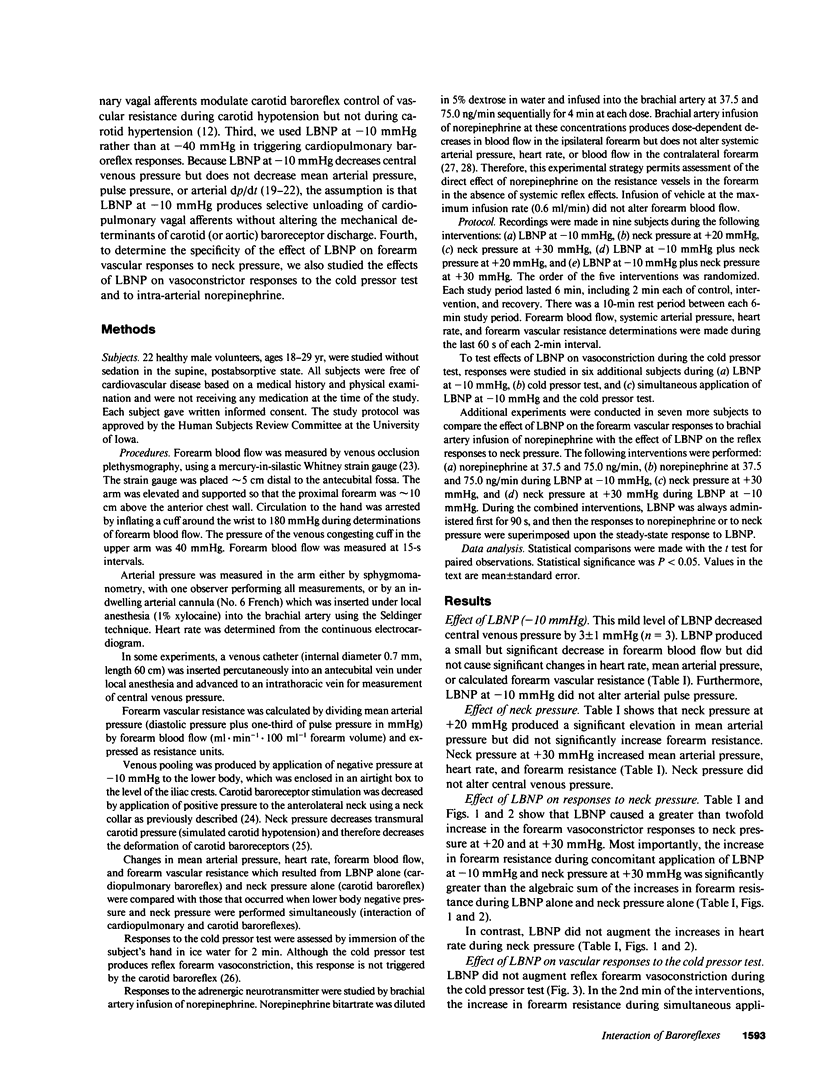
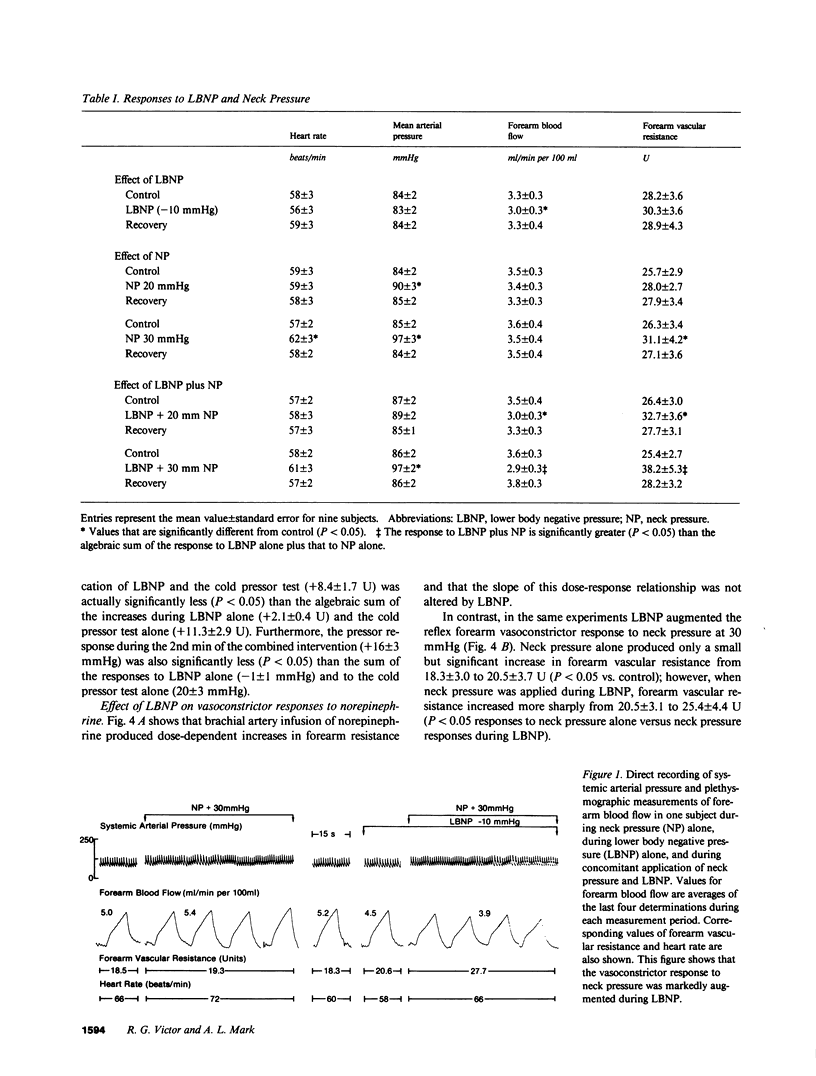
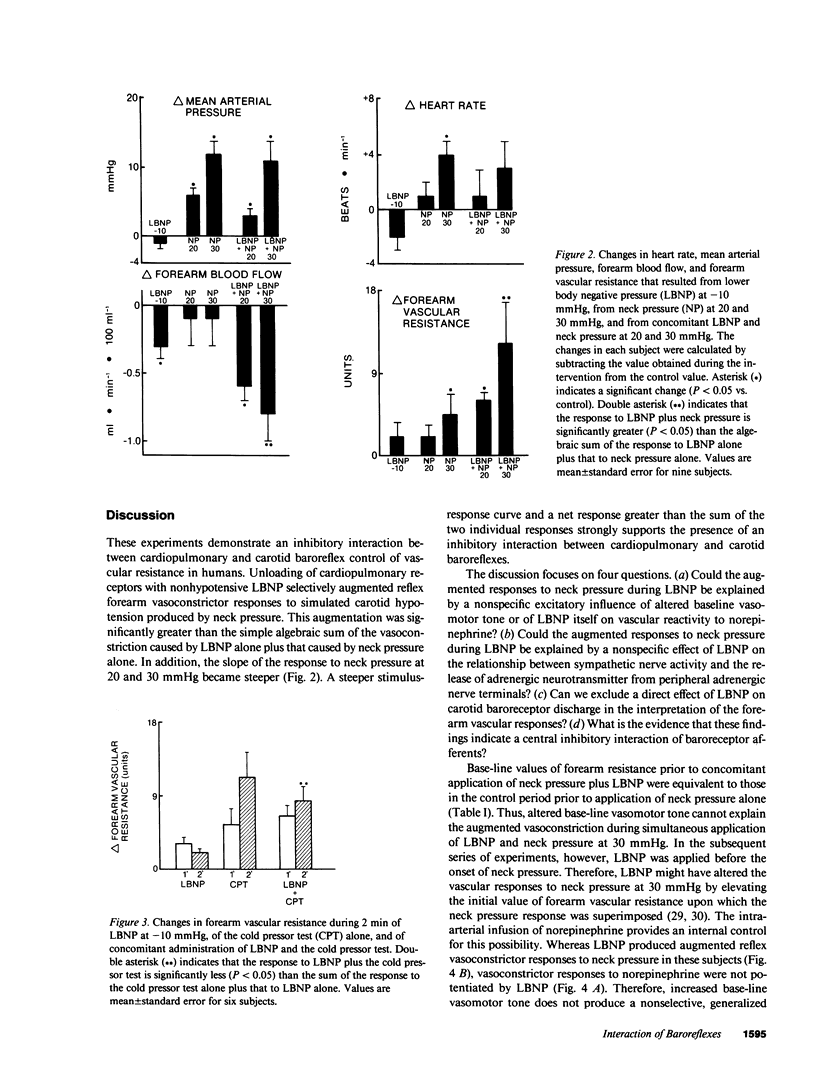
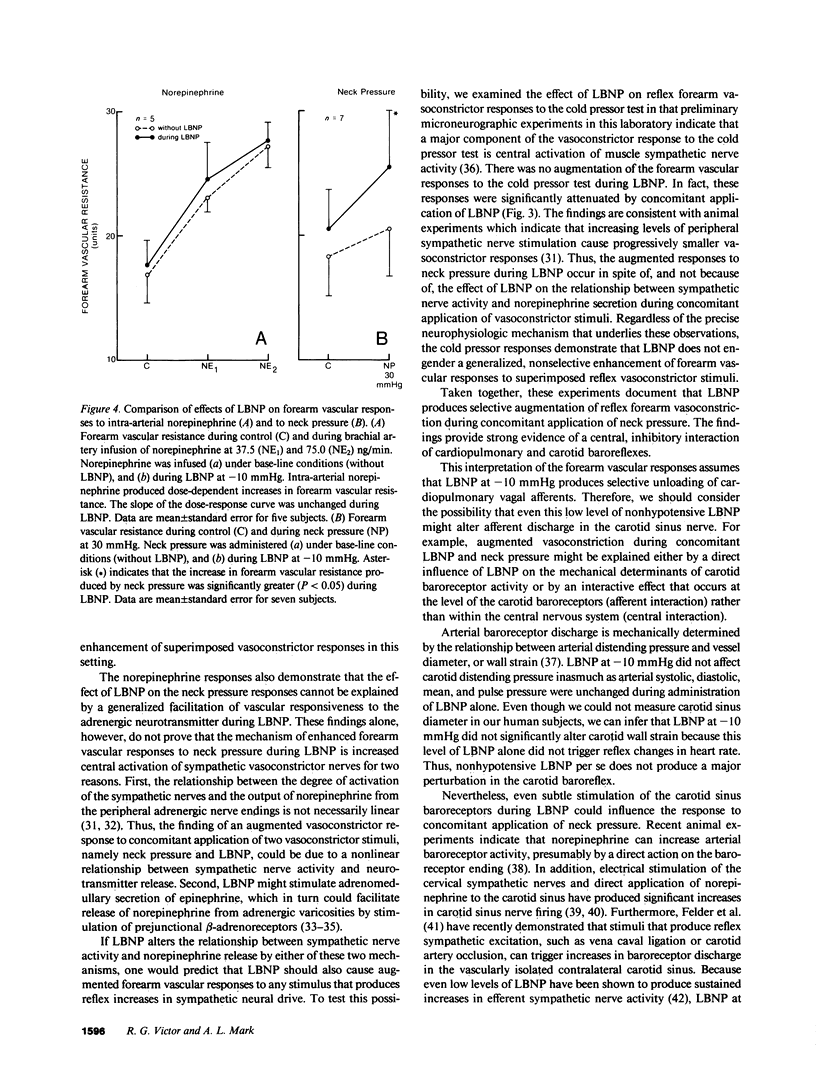
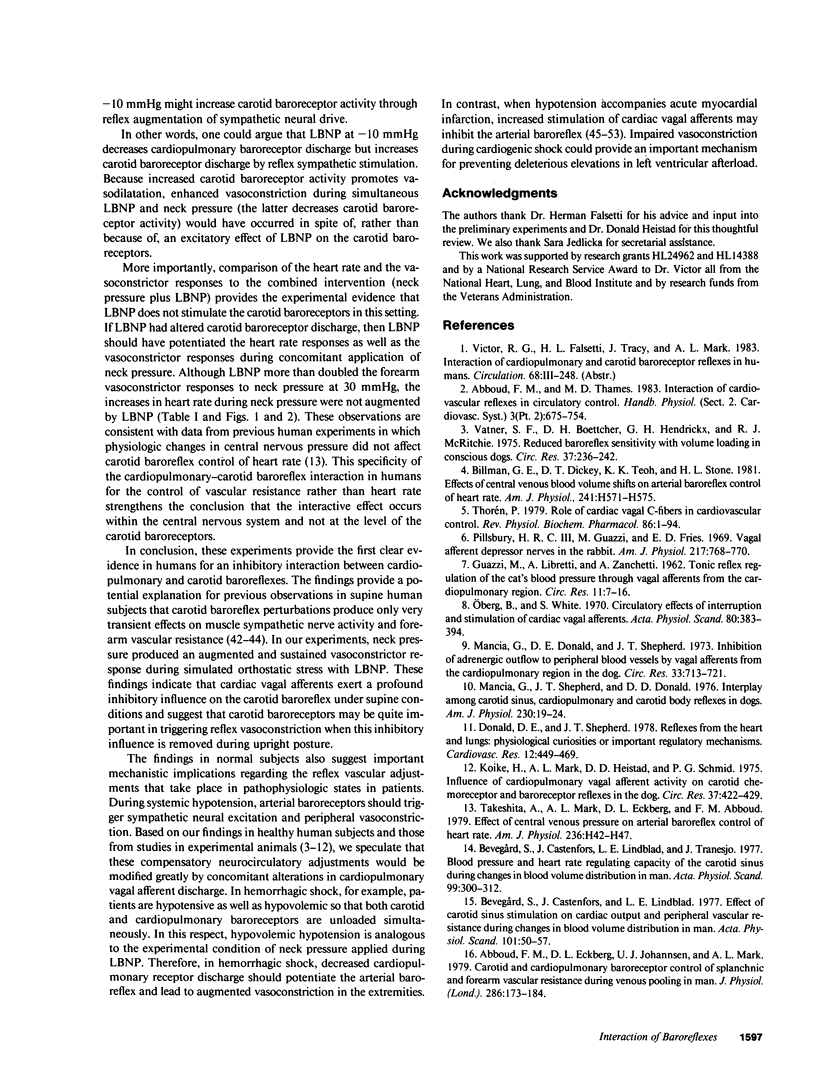
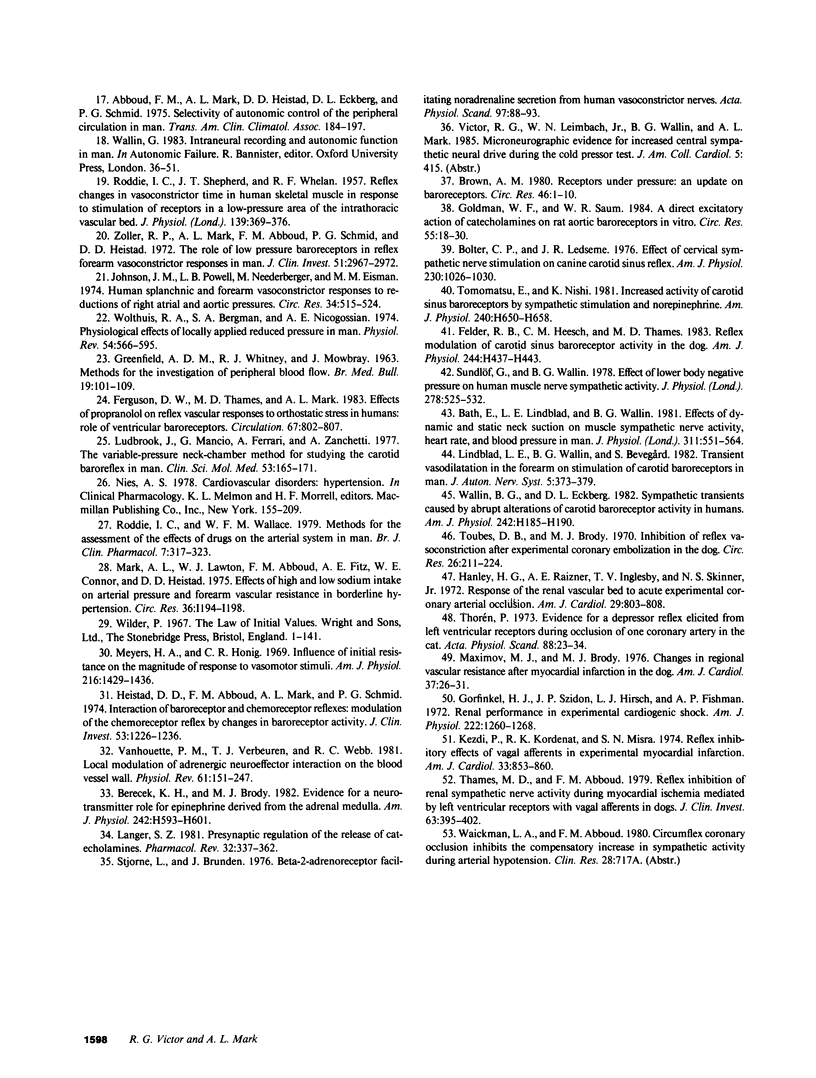
Selected References
These references are in PubMed. This may not be the complete list of references from this article.
- Abboud F. M., Eckberg D. L., Johannsen U. J., Mark A. L. Carotid and cardiopulmonary baroreceptor control of splanchnic and forearm vascular resistance during venous pooling in man. J Physiol. 1979 Jan;286:173–184. doi: 10.1113/jphysiol.1979.sp012612. [DOI] [PMC free article] [PubMed] [Google Scholar]
- Abboud F. M., Mark A. L., Heistad D. D., Eckberg D. L., Schimid P. G. Selectivity of autonomic control of the peripheral circulation in man. Trans Am Clin Climatol Assoc. 1975;86:184–197. [PMC free article] [PubMed] [Google Scholar]
- Berecek K. H., Brody M. J. Evidence for a neurotransmitter role for epinephrine derived from the adrenal medulla. Am J Physiol. 1982 Apr;242(4):H593–H601. doi: 10.1152/ajpheart.1982.242.4.H593. [DOI] [PubMed] [Google Scholar]
- Bevegård S., Castenfors J., Lindblad L. E. Effect of carotid sinus stimulation on cardiac output and peripheral vascular resistance during changes in blood volume distribution in man. Acta Physiol Scand. 1977 Sep;101(1):50–57. doi: 10.1111/j.1748-1716.1977.tb05982.x. [DOI] [PubMed] [Google Scholar]
- Bevegård S., Castenfors J., Lindblad L. E., Tranesjö J. Blood pressure and heart rate regulating capacity of the carotid sinus during changes in blood volume distribution in man. Acta Physiol Scand. 1977 Mar;99(3):300–312. doi: 10.1111/j.1748-1716.1977.tb10383.x. [DOI] [PubMed] [Google Scholar]
- Billman G. E., Dickey D. T., Teoh K. K., Stone H. L. Effects of central venous blood volume shifts on arterial baroreflex control of heart rate. Am J Physiol. 1981 Oct;241(4):H571–H575. doi: 10.1152/ajpheart.1981.241.4.H571. [DOI] [PubMed] [Google Scholar]
- Bolter C. P., Ledsome J. R. Effect of cervical sympathetic nerve stimulation on canine carotid sinus reflex. Am J Physiol. 1976 Apr;230(4):1026–1030. doi: 10.1152/ajplegacy.1976.230.4.1026. [DOI] [PubMed] [Google Scholar]
- Brown A. M. Receptors under pressure. An update on baroreceptors. Circ Res. 1980 Jan;46(1):1–10. doi: 10.1161/01.res.46.1.1. [DOI] [PubMed] [Google Scholar]
- Båth E., Lindblad L. E., Wallin B. G. Effects of dynamic and static neck suction on muscle nerve sympathetic activity, heart rate and blood pressure in man. J Physiol. 1981 Feb;311:551–564. doi: 10.1113/jphysiol.1981.sp013604. [DOI] [PMC free article] [PubMed] [Google Scholar]
- Donald D. E., Shepherd J. T. Reflexes from the heart and lungs: physiological curiosities or important regulatory mechanisms. Cardiovasc Res. 1978 Aug;12(8):446–469. [PubMed] [Google Scholar]
- Felder R. B., Heesch C. M., Thames M. D. Reflex modulation of carotid sinus baroreceptor activity in the dog. Am J Physiol. 1983 Mar;244(3):H437–H443. doi: 10.1152/ajpheart.1983.244.3.H437. [DOI] [PubMed] [Google Scholar]
- Ferguson D. W., Thames M. D., Mark A. L. Effects of propranolol on reflex vascular responses to orthostatic stress in humans. Role of ventricular baroreceptors. Circulation. 1983 Apr;67(4):802–807. doi: 10.1161/01.cir.67.4.802. [DOI] [PubMed] [Google Scholar]
- GREENFIELD A. D., WHITNEY R. J., MOWBRAY J. F. Methods for the investigation of peripheral blood flow. Br Med Bull. 1963 May;19:101–109. doi: 10.1093/oxfordjournals.bmb.a070026. [DOI] [PubMed] [Google Scholar]
- GUAZZI M., LIBRETTI A., ZANCHETTI A. Tonic reflex regulation of the cat's blood pressure through vagal afferents from the cardiopulmonary region. Circ Res. 1962 Jul;11:7–16. [PubMed] [Google Scholar]
- Goldman W. F., Saum W. R. A direct excitatory action of catecholamines on rat aortic baroreceptors in vitro. Circ Res. 1984 Jul;55(1):18–30. doi: 10.1161/01.res.55.1.18. [DOI] [PubMed] [Google Scholar]
- Gorfinkel H. J., Szidon J. P., Hirsch L. J., Fishman A. P. Renal performance in experimental cardiogenic shock. Am J Physiol. 1972 May;222(5):1260–1268. doi: 10.1152/ajplegacy.1972.222.5.1260. [DOI] [PubMed] [Google Scholar]
- Hanley H. G., Raizner A. E., Inglesby T. V., Skinner N. S., Jr Response of the renal vascular bed to acute experimental coronary arterial occlusion. Am J Cardiol. 1972 Jun;29(6):803–808. doi: 10.1016/0002-9149(72)90498-5. [DOI] [PubMed] [Google Scholar]
- Heistad D. D., Abboud F. M., Mark A. L., Schmid P. G. Interaction of baroreceptor and chemoreceptor reflexes. Modulation of the chemoreceptor reflex by changes in baroreceptor activity. J Clin Invest. 1974 May;53(5):1226–1236. doi: 10.1172/JCI107669. [DOI] [PMC free article] [PubMed] [Google Scholar]
- Johnson J. M., Rowell L. B., Niederberger M., Eisman M. M. Human splanchnic and forearm vasoconstrictor responses to reductions of right atrial and aortic pressures. Circ Res. 1974 Apr;34(4):515–524. doi: 10.1161/01.res.34.4.515. [DOI] [PubMed] [Google Scholar]
- Kezdi P., Kordenat R. K., Misra S. N. Reflex inhibitory effects of vagal afferents in experimental myocardial infarction. Am J Cardiol. 1974 Jun;33(7):853–860. doi: 10.1016/0002-9149(74)90632-8. [DOI] [PubMed] [Google Scholar]
- Koike H., Mark A. L., Heistad D. D., Schmid P. G. Influence of cardiopulmonary vagal afferent activity on carotid chemoreceptor and baroreceptor reflexes in the dog. Circ Res. 1975 Oct;37(4):422–429. doi: 10.1161/01.res.37.4.422. [DOI] [PubMed] [Google Scholar]
- Langer S. Z. Presynaptic regulation of the release of catecholamines. Pharmacol Rev. 1980 Dec;32(4):337–362. [PubMed] [Google Scholar]
- Lindblad L. E., Wallin B. G., Bevegård S. Transient vasodilatation in forearm on stimulation of carotid baroreceptors in man. J Auton Nerv Syst. 1982 May;5(3):373–379. doi: 10.1016/0165-1838(82)90078-9. [DOI] [PubMed] [Google Scholar]
- Ludbrook J., Mancia G., Ferrari A., Zanchetti A. The variable-pressure neck-chamber method for studying the carotid baroreflex in man. Clin Sci Mol Med. 1977 Aug;53(2):165–171. doi: 10.1042/cs0530165. [DOI] [PubMed] [Google Scholar]
- Mancia G., Donald D. E., Shepherd J. T. Inhibition of adrenergic outflow to peripheral blood vessels by vagal afferents from the cardiopulmonary region in the dog. Circ Res. 1973 Dec;33(6):713–721. doi: 10.1161/01.res.33.6.713. [DOI] [PubMed] [Google Scholar]
- Mancia G., Shepherd J. T., Donald D. E. Interplay among carotid sinus, cardiopulmonary, and carotid body reflexes in dogs. Am J Physiol. 1976 Jan;230(1):19–24. doi: 10.1152/ajplegacy.1976.230.1.19. [DOI] [PubMed] [Google Scholar]
- Maximov M. J., Brody M. J. Changes in regional vascular resistance after myocardial infarction in the dog. Am J Cardiol. 1976 Jan;37(1):26–32. doi: 10.1016/0002-9149(76)90495-1. [DOI] [PubMed] [Google Scholar]
- Myers H. A., Honig C. R. Influence of initial resistance on magnitude of response to vasomotor stimuli. Am J Physiol. 1969 Jun;216(6):1429–1436. doi: 10.1152/ajplegacy.1969.216.6.1429. [DOI] [PubMed] [Google Scholar]
- Oberg B., White S. Circulatory effects of interruption and stimulation of cardiac vagal afferents. Acta Physiol Scand. 1970 Nov;80(3):383–394. doi: 10.1111/j.1748-1716.1970.tb04802.x. [DOI] [PubMed] [Google Scholar]
- Pillsbury H. R., 3rd, Guazzi M., Freis E. D. Vagal afferent depressor nerves in the rabbit. Am J Physiol. 1969 Sep;217(3):768–770. doi: 10.1152/ajplegacy.1969.217.3.768. [DOI] [PubMed] [Google Scholar]
- RODDIE I. C., SHEPHERD J. T., WHELAN R. F. Reflex changes in vasoconstrictor tone in human skeletal muscle in response to stimulation of receptors in a low-pressure area of the intrathoracic vascular bed. J Physiol. 1957 Dec 31;139(3):369–376. doi: 10.1113/jphysiol.1957.sp005897. [DOI] [PMC free article] [PubMed] [Google Scholar]
- Roddie I. C., Wallace W. F. Methods for the assessment of the effects of drugs on the arterial system in man. Br J Clin Pharmacol. 1979 Apr;7(4):317–323. doi: 10.1111/j.1365-2125.1979.tb00940.x. [DOI] [PMC free article] [PubMed] [Google Scholar]
- Stjärne L., Brundin J. Beta2-adrenoceptors facilitating noradrenaline secretion from human vasoconstrictor nerves. Acta Physiol Scand. 1976 Mar;97(1):88–93. doi: 10.1111/j.1748-1716.1976.tb10238.x. [DOI] [PubMed] [Google Scholar]
- Sundlöf G., Wallin B. G. Effect of lower body negative pressure on human muscle nerve sympathetic activity. J Physiol. 1978 May;278:525–532. doi: 10.1113/jphysiol.1978.sp012322. [DOI] [PMC free article] [PubMed] [Google Scholar]
- Takeshita A., Mark A. L., Eckberg D. L., Abboud F. M. Effect of central venous pressure on arterial baroreflex control of heart rate. Am J Physiol. 1979 Jan;236(1):H42–H47. doi: 10.1152/ajpheart.1979.236.1.H42. [DOI] [PubMed] [Google Scholar]
- Thames M. D., Abboud F. M. Reflex inhibition of renal sympathetic nerve activity during myocardial ischemia mediated by left ventricular receptors with vagal afferents in dogs. J Clin Invest. 1979 Mar;63(3):395–402. doi: 10.1172/JCI109315. [DOI] [PMC free article] [PubMed] [Google Scholar]
- Thorén P. Evidence for a depressor reflex elicited from left ventricular receptors during occlusion of one coronary artery in the cat. Acta Physiol Scand. 1973 May;88(1):23–34. doi: 10.1111/j.1748-1716.1973.tb05430.x. [DOI] [PubMed] [Google Scholar]
- Thorén P. Role of cardiac vagal C-fibers in cardiovascular control. Rev Physiol Biochem Pharmacol. 1979;86:1–94. doi: 10.1007/BFb0031531. [DOI] [PubMed] [Google Scholar]
- Tomomatsu E., Nishi K. Increased activity of carotid sinus baroreceptors by sympathetic stimulation and norepinephrine. Am J Physiol. 1981 Apr;240(4):H650–H658. doi: 10.1152/ajpheart.1981.240.4.H650. [DOI] [PubMed] [Google Scholar]
- Toubes D. B., Brody M. J. Inhibition of reflex vasoconstriction after experimental coronary embolization in the dog. Circ Res. 1970 Feb;26(2):211–224. doi: 10.1161/01.res.26.2.211. [DOI] [PubMed] [Google Scholar]
- Vanhoutte P. M., Verbeuren T. J., Webb R. C. Local modulation of adrenergic neuroeffector interaction in the blood vessel well. Physiol Rev. 1981 Jan;61(1):151–247. doi: 10.1152/physrev.1981.61.1.151. [DOI] [PubMed] [Google Scholar]
- Vatner S. F., Boettcher D. H., Heyndrickx G. R., McRitchie R. J. Reduced baroreflex sensitivity with volume loading in conscious dogs. Circ Res. 1975 Aug;37(2):236–242. doi: 10.1161/01.res.37.2.236. [DOI] [PubMed] [Google Scholar]
- Wallin B. G., Eckberg D. L. Sympathetic transients caused by abrupt alterations of carotid baroreceptor activity in humans. Am J Physiol. 1982 Feb;242(2):H185–H190. doi: 10.1152/ajpheart.1982.242.2.H185. [DOI] [PubMed] [Google Scholar]
- Wolthuis R. A., Bergman S. A., Nicogossian A. E. Physiological effects of locally applied reduced pressure in man. Physiol Rev. 1974 Jul;54(3):566–595. doi: 10.1152/physrev.1974.54.3.566. [DOI] [PubMed] [Google Scholar]
- Zoller R. P., Mark A. L., Abboud F. M., Schmid P. G., Heistad D. D. The role of low pressure baroreceptors in reflex vasoconstrictor responses in man. J Clin Invest. 1972 Nov;51(11):2967–2972. doi: 10.1172/JCI107121. [DOI] [PMC free article] [PubMed] [Google Scholar]


